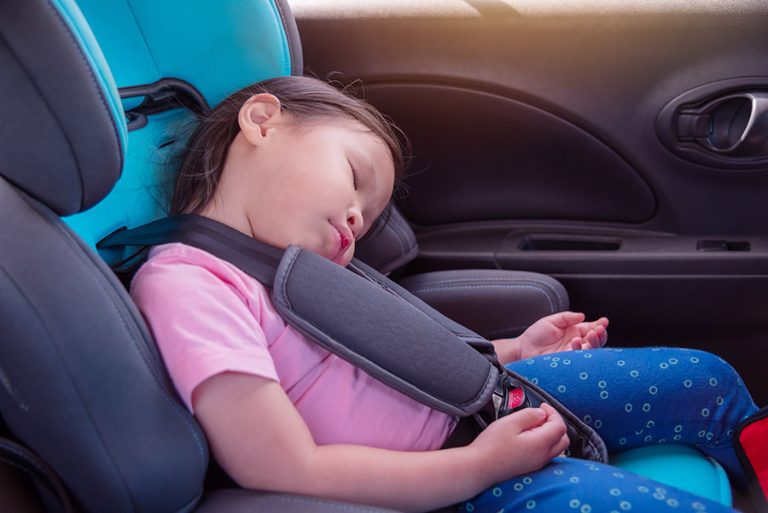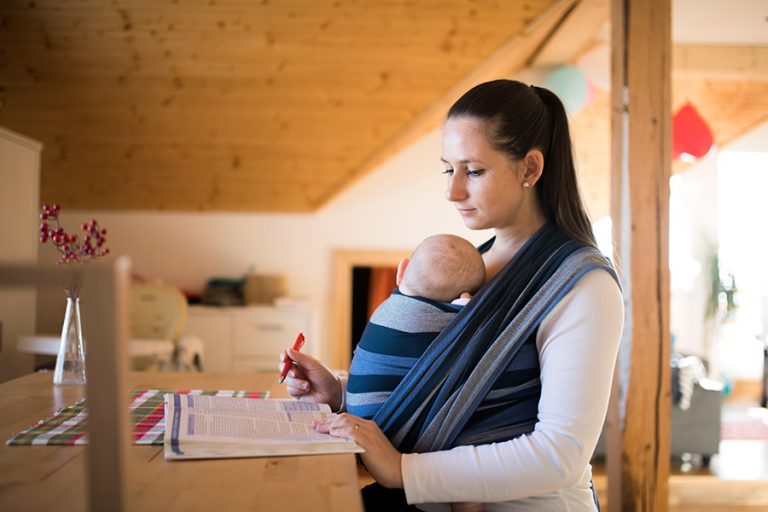Protecting Infants and Toddlers from Positional Asphyxia: Car Seats and Sling Carriers
What is Positional Asphyxia?
Babies who experience positional asphyxia cannot breathe because the position of their body blocks their airway. This can occur in several ways:
- When the mouth and nose are blocked by something covering them.
- When the passage of air from mouth and nose to lungs is blocked because a baby’s head is slumped over or a baby’s chin is pressing into the baby’s chest.
Why Do We Care About Positional Asphyxia?
- Reduced oxygen levels can lead to later cognitive or behavioral problems.
- Babies die quickly when they cannot breathe – it takes just a few minutes.
Who is at Risk for Positional Asphyxia and Why?
Newborns and young infants are at high risk because they cannot move themselves in order to breathe when their airway is blocked. Within this group, premature and low birthweight infants appear to be at the greatest risk for many reasons. Breathing problems, being too small for the seat and an inability to sit in the semi-upright position needed to keep breathing in the car seat are factors.
Older infants and toddlers have also died from positional  asphyxia. This has happened when car seats are placed on beds and other furniture
and roll over and trap the infant or toddler. Infants and toddlers left to sleep in
a car seat have also died when they slump and rest their chin on their chest, restricting
or stopping breathing. Infants and toddlers awake but unattended in a car seat or
sling have died because their movements may block their nose and mouth, preventing
breathing.
asphyxia. This has happened when car seats are placed on beds and other furniture
and roll over and trap the infant or toddler. Infants and toddlers left to sleep in
a car seat have also died when they slump and rest their chin on their chest, restricting
or stopping breathing. Infants and toddlers awake but unattended in a car seat or
sling have died because their movements may block their nose and mouth, preventing
breathing.
Research Findings
- When car seat straps are loose, babies can slump, leading to asphyxiation or be strangled. One 2015 study showed 69 percent of families with newborns left the car seat straps too loose (Hoffman, Gallardo, & Carlson, 2016).
- From 2004 through 2008, 31 infant and toddler deaths by asphyxiation in car seats were included in data provided by U.S. Consumer Product Safety Commission (CPSC); 48 percent were due to positional asphyxia (Batra, Midgett, & Moon, 2015).
- From 2004 through 2008, five infant deaths in slings were identified from data provided by U.S. Consumer Products Safety Commission; 100 percent were due to positional asphyxia (Batra et al., 2015).
Positional Asphyxia and Sitting and Carrying Devices
Car seats and sling carriers are products of concern. One study found that out of 47 deaths, 31 (66 percent) occurred in car seats and five (11 percent) in slings. The rest occurred in swings, bouncers and strollers (Batra et al., 2015).
Car Seats
Car seats are safe as long as they are used appropriately. Car seats protect infants and children from injury and death in car accidents. But car seats are not designed for safe sleeping or for unsupervised awake time. NEVER leave a child unattended.
Car seats are a wonderful product designed to increased child safety in one situation only — riding in a vehicle. Car seats protect infants and children from serious injury and death in vehicle collisions. Car seats do not increase safety in any other circumstances and should only be used in vehicles.
Car Seats: Reduce Risk
Be sure to read and follow all other instructions provided by the manufacturer. A certified child passenger safety technician should inspect the car seat to make sure it has been properly installed. People caring for your baby, including grandparents, other relatives, babysitters and childcare providers, should know how to use the seat. All rear-facing car seats for newborns should be installed at a 45-degree angle and adjusted according to manufacturer recommendations.
Make sure that everyone using the car seat practices how to install the seat and harness the baby with a child passenger safety technician. The state or county health department can be called for assistance. Visit Safer Car for more information.
- Loose straps or harness can trap infant’s head or neck; follow manufacturer’s instructions
 to ensure that the straps are properly adjusted.
to ensure that the straps are properly adjusted. - Car seats should only be used in a car or other vehicle.
- Infants in a car seat should be able to be observed by a responsible adult.
- Whenever possible, an adult should ride in the back seat with baby to check baby’s head and neck position and breathing.
- Use only straps to position baby correctly and do not add pillows or blankets.
- Straps should always be completely buckled.
- Make sure baby’s chin is up at all times.
Sling Carriers
The U.S. Consumer Product Safety Commission states that sling carriers are sewn products designed to hold a child upright or in a reclined position while supported by a caregiver’s torso. There are three main types of sling carriers. Ring slings are shaped like hammocks. Adjustments are made by tightening or loosening the sling fabric through rings. Pouch slings are similar. Some use buckles to adjust size. Wrap slings are pieces of fabric with no fasteners. The caregiver wraps the fabric around their body and the child for support (U.S. Consumer Product Safety Commission, 2014). Regardless of the type of sling, be sure to read and follow all other instructions provided by the manufacturer.
Sling Carriers: Reduce Risk
The U.S. Consumer Product Safety Commission and other U.S. recommendations:
- Loose sling carriers can cause infants to slump down – restricting or cutting off their airway. The person wearing the sling should frequently check on the baby’s position and breathing.
- The sling carrier can cover the infant’s mouth and nose, preventing breathing. The baby’s face should be “visible and kissable.”
- After nursing a baby in a sling carrier, the mother should change the baby’s position, so that baby’s face is looking up and not blocked by the sling or the mother’s body.
- The person wearing the sling should frequently check on the baby’s position and breathing.
Keep your family safe! Use car seats and sling carriers safely to minimize risk of positional asphyxia.
References
Australian Competition & Consumer Commission. (2014). What you need to know about baby slings.
Batra, E. K., Midgett, J. D., & Moon, R. Y. (2015). Hazards associated with sitting and carrying devices for children two years and younger. The Journal of Pediatrics, 167(1), 183-187.
Bull, M. J., & Engle, W. A. (2009). Safe transportation of preterm and low birth weight infants at hospital discharge. Pediatrics, 123(5), 1424-1429.
Cerar, L. K., Scirica, C. V., Gantar, I. Š., Osredkar, D., Neubauer, D., & Kinane, T. B. (2009). A comparison of respiratory patterns in healthy term infants placed in car safety seats and beds. Pediatrics, 124(3), e396-e402.
Cote, A., Bairam, A., Deschenes, M., & Hatzakis, G. (2008). Sudden infant deaths in sitting devices. Archives of Disease in Childhood, 93(5), 384-389.
Hoffman, B. D., Gallardo, A. R., & Carlson, K. F. (2016). Unsafe from the start: serious misuse of car safety seats at newborn discharge. The Journal of Pediatrics, 171, 48-54.
Merchant, J. R., Worwa, C., Porter, S., & Coleman, J. M. (2001). Respiratory instability of term and near-term healthy newborn infants in car safety seats. Pediatrics, 108(3), 647-652.
Moon, R. Y. (2011). SIDS and other sleep-related infant deaths: expansion of recommendations for a safe infant sleeping environment. Pediatrics, 128(5), e1341-e1367.
Queensland Government. (2016). Safety advice and warnings – baby products: Baby slings.
Smith, R. W., Mohamed, A., Young, J., Jefferies, A., & Shah, V. (2016). Factors associated with car seat test failure in late preterm infants: A retrospective chart review. Pediatrics & Child Health, 21(1).
U.S. Consumer Product Safety Commission. (2010). Infant deaths prompt CPSC warning about sling carriers for babies.
U.S. Consumer Product Safety Commission. (2014). Proposed Rule: Safety Standard for Sling Carriers.
Reviewers
Ali Dodd, Consumer
Regina McCurdy, Oklahoma State Department of Health
Brenda Miller, Oklahoma State University
Lesa Rauh, Oklahoma State University
Laura Hubbs-Tait, Ph.D.
Extension Parenting Specialist
Gina Peek, Ph.D.
Extension Housing and Consumer Specialist
